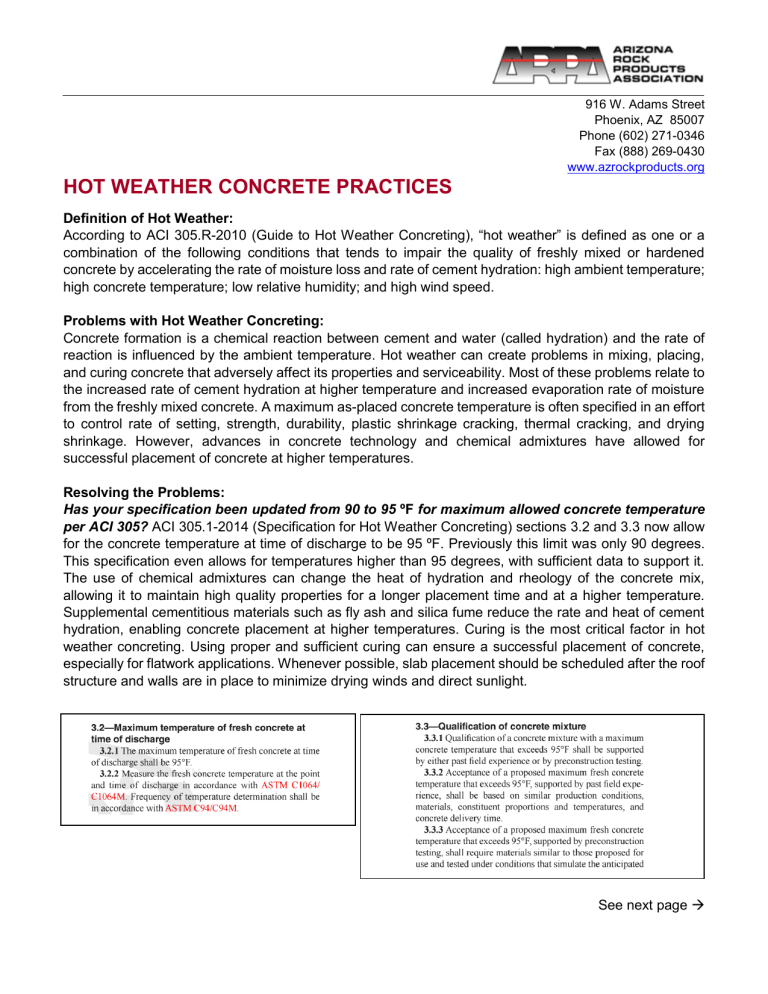
916 W. Adams Street Phoenix, AZ 85007 Phone (602) 271-0346 Fax (888) 269-0430 www.azrockproducts.org HOT WEATHER CONCRETE PRACTICES Definition of Hot Weather: According to ACI 305.R-2010 (Guide to Hot Weather Concreting), “hot weather” is defined as one or a combination of the following conditions that tends to impair the quality of freshly mixed or hardened concrete by accelerating the rate of moisture loss and rate of cement hydration: high ambient temperature; high concrete temperature; low relative humidity; and high wind speed. Problems with Hot Weather Concreting: Concrete formation is a chemical reaction between cement and water (called hydration) and the rate of reaction is influenced by the ambient temperature. Hot weather can create problems in mixing, placing, and curing concrete that adversely affect its properties and serviceability. Most of these problems relate to the increased rate of cement hydration at higher temperature and increased evaporation rate of moisture from the freshly mixed concrete. A maximum as-placed concrete temperature is often specified in an effort to control rate of setting, strength, durability, plastic shrinkage cracking, thermal cracking, and drying shrinkage. However, advances in concrete technology and chemical admixtures have allowed for successful placement of concrete at higher temperatures. Resolving the Problems: Has your specification been updated from 90 to 95 ºF for maximum allowed concrete temperature per ACI 305? ACI 305.1-2014 (Specification for Hot Weather Concreting) sections 3.2 and 3.3 now allow for the concrete temperature at time of discharge to be 95 ºF. Previously this limit was only 90 degrees. This specification even allows for temperatures higher than 95 degrees, with sufficient data to support it. The use of chemical admixtures can change the heat of hydration and rheology of the concrete mix, allowing it to maintain high quality properties for a longer placement time and at a higher temperature. Supplemental cementitious materials such as fly ash and silica fume reduce the rate and heat of cement hydration, enabling concrete placement at higher temperatures. Curing is the most critical factor in hot weather concreting. Using proper and sufficient curing can ensure a successful placement of concrete, especially for flatwork applications. Whenever possible, slab placement should be scheduled after the roof structure and walls are in place to minimize drying winds and direct sunlight. See next page Chemical Admixtures: Did you know that with chemical admixtures, concrete can be retarded up to 8 hours without negatively affecting its properties? Various types of chemical admixtures (ASTM C494) are found to be beneficial in offsetting some of the undesirable characteristics of concrete placed during high ambient temperatures. Hydration stabilizers are a category of admixtures that allow for more working time for fresh concrete by retarding its setting time. The benefits of these admixtures can include lower mixing water demand, extended periods of use, and strengths comparable with, or higher than, concrete without admixtures placed at lower temperatures. Their effectiveness depends on the chemical formulations and their reactions of the cement used in the concrete. ACI 305.1-2014 section 5.7 prohibits adding water in excess of the proportioned w/c ratio in the original mix. Loss of slump can only be compensated using chemical admixtures. Curing Methods: Does your specification meet the requirements of ASTM C309 for curing compounds? Curing is the most critical factor in hot weather concreting and should not be ignored. A variety of curing methods are described in ACI 308R. Initial curing techniques, such as fog spray, can be used to ensure timely replacement of bleed-water and to avoid plastic shrinkage cracking. As described in ACI 305R, moist curing is the best method for maximizing strength and durability of concrete flatwork. Examples of moist curing methods are ponding, covering exposed concrete surfaces with clean sand kept continuously wet, fog-spraying, or continuous sprinkling. For moist curing, use water with a temperature no more than 20°F cooler than the concrete temperature if applicable. Where job conditions do not allow for moist curing, use liquid membrane-forming curing compounds (ACI 305R). The membrane restricts the loss of moisture from the concrete, thereby allowing the development of strength, durability, and abrasion resistance of the surface. Membrane-forming curing compound should meet the requirements of ASTM C309. Curing materials should be readily available at the project site. Fiber-Reinforcement for Minimizing Cracks: Has your specification been updated for fiber-reinforcement per ASTM C1116 and ACI 544? In addition to proper mix design, material selection and curing, another typical method to minimize crack width and spacing for flatwork is the use of reinforcement (mesh, rebar or fibers). There are always practical difficulties with placing steel mesh and rebar in a slab. Even with proper placement, the concrete cover remains un-reinforced with a potential for surface cracking. The only way to reinforce concrete threedimensionally is by using fibers. ASTM C1116 is the standard specification for fiber-reinforced concrete. Microfibers are added to concrete as a secondary reinforcement and are effective in controlling plastic shrinkage cracks and sometimes drying shrinkage cracks. Macrofibers (steel or synthetic) can be used in concrete either as an addition or as a replacement of mesh/bars. These fibers provide 3-D reinforcement for the whole concrete section, resulting is smaller cracks, if any. Macrofibers provide post-crack tensile and flexural capacity to the concrete and can be designed to provide the required engineering properties. Refer to ACI 544 (Fiber-Reinforced Concrete) publications for more information on the use of concrete fibers, applications, design, and practice. Conclusions and Recommendations: Being aware of the issues and available solutions involved in hot weather concreting is important to the ultimate performance of the concrete. Proper use of current guidelines, best practices, and new technology, as provided for in the referenced technical documentation and test methods can allow for successful performance of concrete in hot weather situations.
